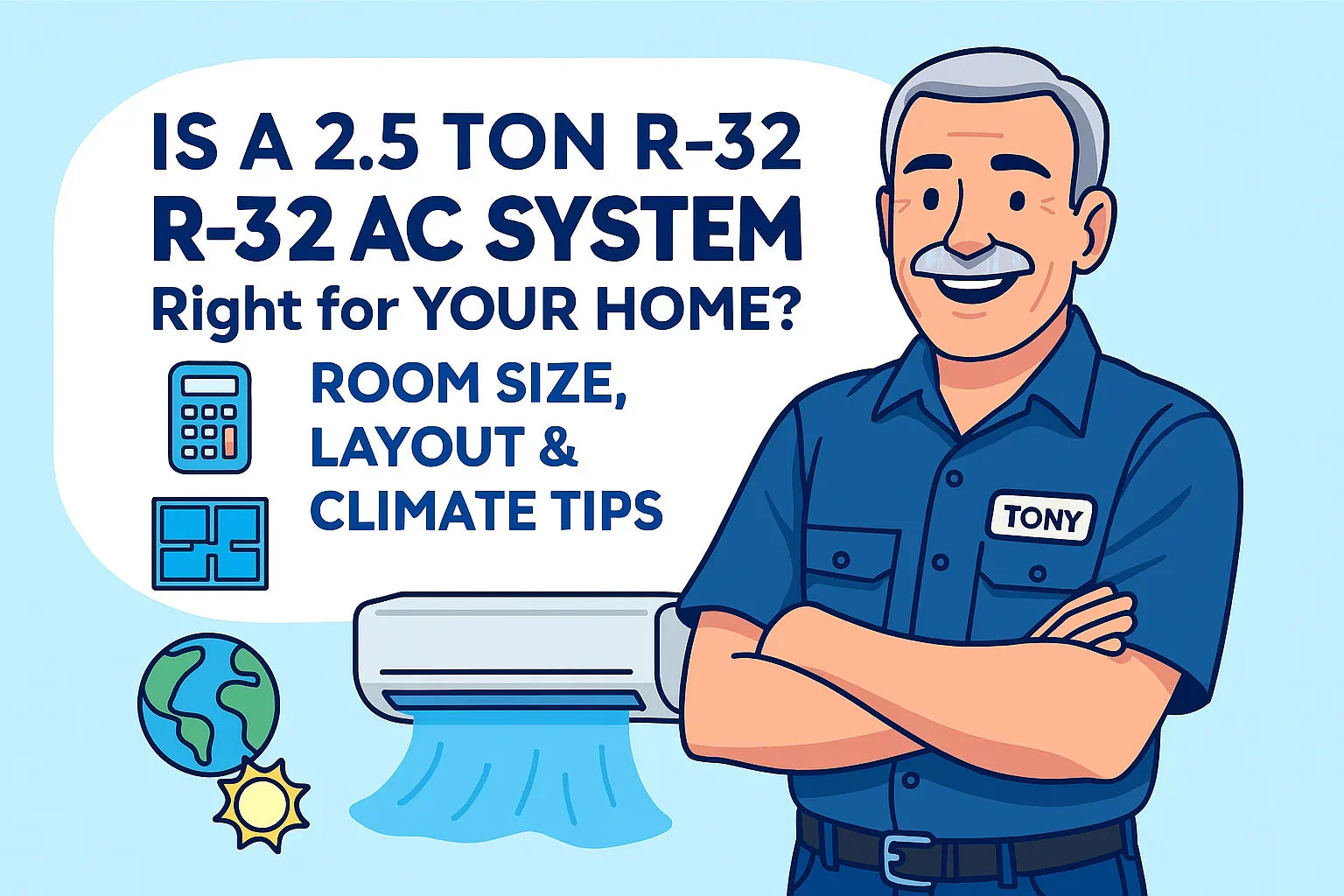When shopping for a new central air conditioning system, it's easy to focus on features, refrigerants, or price. But before all that, you have to answer one core question: is a 2.5-ton R-32 AC system the right size for your home? In this guide, we'll help you break it down using proven HVAC sizing principles, real-world layout examples, and key climate considerations. Whether you're replacing an old unit or upgrading to a more energy-efficient system, getting the sizing right is essential for comfort, performance, and efficiency.
⚖️ What Does "2.5 Ton" Mean in AC Sizing?
AC "tonnage" doesn't refer to the weight of the unit—it refers to the amount of heat it can remove in an hour. One ton equals 12,000 BTUs/hour, so a 2.5-ton AC system provides 30,000 BTUs/hour of cooling.
If your system is too small, it will struggle to cool your space. Too large, and it may cycle on and off too frequently, reducing efficiency and failing to dehumidify.
Learn more from the U.S. Department of Energy's AC sizing primer.
🌍 Step 1: Understand Your Regional Climate Zone
Your home’s geographic location affects the cooling capacity you need. The U.S. is divided into five general climate zones:
-
Zone 1 (Hot-Humid) — Florida, Southern Texas, Coastal Louisiana
-
Zone 2 (Hot-Dry) — Arizona, Southern Nevada
-
Zone 3 (Mixed) — California, Carolinas, Mid-Atlantic
-
Zone 4 (Cool) — Oregon, Northern Plains
-
Zone 5 (Cold) — Northern New England, Upper Midwest
In hot-humid regions, a 2.5-ton system may only be ideal for 1,200–1,400 sq. ft. But in cool zones, it may effectively cool 1,600–1800 sq. ft.
For local climate data, consult the ASHRAE Climate Zone Map.
🏠 Step 2: Square Footage & Insulation Matter
Here's a rough guide for how many square feet a 2.5-ton AC system can cool, depending on home insulation and sun exposure:
| Home Type | Sq. Ft. Range (Typical) |
|---|---|
| Poorly Insulated | 1,000–1,300 sq. ft. |
| Average Insulated | 1,400–1,600 sq. ft. |
| Well Insulated | 1,700–1,900 sq. ft. |
Pro Tip: Use a Manual J Load Calculation for accurate sizing. Many online tools offer this service, such as the LoadCalc HVAC tool.
🛏️ Step 3: Room-by-Room Cooling Needs
Not all rooms are created equal. Some will need more cooling power than others:
-
🎓 Home Office: 5,000–6,000 BTUs if south-facing with electronics
-
🎶 Living Room: 8,000–12,000 BTUs
-
🍽️ Kitchen: Add 4,000 BTUs to account for appliance heat
-
🛌 Bedrooms: 4,000–6,000 BTUs each
-
🌊 Sunroom: Add 20% more BTUs if exposed to direct sunlight most of the day
If your layout includes open spaces or vaulted ceilings, a 2.5-ton system may fall short. For a segmented layout with good airflow, it may be just right.
Room-by-room BTU sizing is available from Energy Star's guide.
⚖️ Step 4: What Makes R-32 Different from Other Systems?
R-32 refrigerant is gaining popularity in residential systems for its low global warming potential (GWP). Here's why Tony and other homeowners are making the switch:
-
🌿 Lower GWP than R-410A: About 675 vs. 2,088
-
🚫 Not part of the phase-out: Meets 2025 EPA standards
-
✅ More efficient heat transfer: Meaning smaller coils and faster cooling
-
🚀 Supports higher SEER2 ratings: Often seen in Energy Star-qualified units
Learn more about the benefits from Daikin's R-32 Resource Center.
⚡ Layout Types That Work Best for 2.5 Ton Systems
🏠 1-Story Ranch Homes (1,400–1,800 sq. ft.)
-
Great airflow if ductwork is central
-
Minimal sun exposure on sides of home
🏘 Townhomes
-
Typically narrower but stacked floors reduce sun exposure
-
Good candidates if ductwork is efficient
🏚 Open Concept Bungalows
-
May need zoning or dampers for airflow balance
-
Large living areas could benefit from two returns
Avoid 2.5-ton units in:
-
Homes over 2,000 sq. ft.
-
Poorly insulated attics or crawl spaces
-
Spaces with more than 4 large, sunny rooms
🧹 SEER2 Ratings and Energy Efficiency in 2025
Most R-32 systems on the market today carry SEER2 ratings between 14.3 and 18+, making them compliant with modern energy standards:
-
14.3 SEER2: Meets new federal minimum
-
16+ SEER2: Qualifies for rebates and better ROI
A higher SEER2 rating can save Tony hundreds of dollars per year on utility bills.
🎓 What the Manual J Load Calculation Considers
The Manual J is the gold standard for residential HVAC sizing. It evaluates:
-
Square footage
-
Window type and placement
-
Wall insulation
-
Attic and crawl space conditions
-
Number of occupants
-
Appliances
-
Climate zone
Some contractors provide free load calculations, or use a certified tool like CoolCalc.
🏫 Choosing the Right Air Handler for Your 2.5 Ton System
Don't just match condenser tonnage—your air handler must also:
-
Be compatible with R-32 refrigerant
-
Have proper airflow (CFM) to match BTUs
-
Offer multi-speed or variable-speed options
-
Fit the available space (closet, attic, garage)
🚪 Final Thoughts: Right System, Right Results
A 2.5-ton R-32 system is a solid middle-ground choice for many mid-sized homes. But as we've shown, square footage alone isn't enough. Use this guide to take a holistic view—layout, insulation, climate, and load—before you commit.
If you're still unsure, consider requesting a sizing consultation or using a virtual tool like HVACDirect’s Sizing Estimator.
In the next topic we will know more about: R-32 vs. R-410A: What Tony Needs to Know Before Replacing His AC







